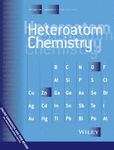Synthesis and characterization of isosorbide bis-phosphorus esters
Yoseph G. Daniel
Department of Chemistry and Biochemistry, Center for Applications in Polymer Science, Central Michigan University, Mt. Pleasant, MI, USA
Search for more papers by this authorCorresponding Author
Bob A. Howell
Department of Chemistry and Biochemistry, Center for Applications in Polymer Science, Central Michigan University, Mt. Pleasant, MI, USA
Correspondence
Bob A. Howell, Department of Chemistry and Biochemistry, Center for Applications in Polymer Science, Central Michigan University, Mt. Pleasant, MI, USA.
Email: [email protected]
Search for more papers by this authorYoseph G. Daniel
Department of Chemistry and Biochemistry, Center for Applications in Polymer Science, Central Michigan University, Mt. Pleasant, MI, USA
Search for more papers by this authorCorresponding Author
Bob A. Howell
Department of Chemistry and Biochemistry, Center for Applications in Polymer Science, Central Michigan University, Mt. Pleasant, MI, USA
Correspondence
Bob A. Howell, Department of Chemistry and Biochemistry, Center for Applications in Polymer Science, Central Michigan University, Mt. Pleasant, MI, USA.
Email: [email protected]
Search for more papers by this authorAbstract
The synthesis of polymers and polymer additives from renewable biosources is of increasing interest. Products based on biosources offer independence from the uncertainty and fluctuation in petrochemical markets and may offer clear advantages over petrochemical counterparts in terms of toxicity, biodegradability, and environmental impact. Isosorbide is a diether diol available from glucose which may be obtained from starch produced by a variety of seed crops. Isosorbide may be converted to a variety of bis-phosphorus esters (phosphinate, phosphonate, phosphate) using either direct phosphorylation or the Atherton-Todd procedure.
Supporting Information
| Filename | Description |
|---|---|
| hc21369-sup-0001-SupInfo.docxWord document, 450.7 KB |
Please note: The publisher is not responsible for the content or functionality of any supporting information supplied by the authors. Any queries (other than missing content) should be directed to the corresponding author for the article.
REFERENCES
- 1M. R. Reddy, S. Vivekanandhan, M. Misra, S. K. Bhatia, A. K. Mohanty, Prog. Polym. Sci. 2013, 38, 1653.
- 2M. Malinconico, P. Cerruti, G. Santagata, B. Immirzi, Macromol. Symp. 2014, 337, 124.
- 3A. Soroudi, I. Jakubowicz, Eur. Polym. J. 2013, 49, 2839.
- 4M. Bocque, C. Voirin, V. Lapinte, S. Caillol, J.-J. Robin, J. Polym. Sci. Part A Polym. Chem. 2016, 54, 11.
- 5M. D. Rowe, E. Eyiler, K. B. Walters, J. Appl. Polym. Sci. 2016, 133, 43917.
- 6M. Winkler, T. M. Lacerda, F. Mack, M. A. R. Meier, Macromolecules 2015, 48, 1398.
- 7T. Willke, K.-D. Vorlop, Appl. Microbiol. Biotechnol. 2004, 66, 131.
- 8T. Zhang, B. A. Howell, A. Dumitrascu, S. J. Martin, P. B. Smith, Polymer 2014, 55, 5065.
- 9B. Yin, M. Hakkarainen, J. Appl. Polym. Sci. 2011, 119, 2400.
- 10S. Doppalapudi, A. Jain, W. Khan, A. J. Domb, Polym. Adv. Technol. 2014, 25, 427.
- 11G. Q. Chen, M. K. Patel, Chem. Rev. 2012, 112, 2082.
- 12M. J. L. Tschan, E. Brule, P. Hapquette, C. M. Thomas, Polym. Chem. 2012, 3, 836.
- 13L. Shen, J. Haufe, M. K. Patel, Product Overview and Market Projection of Emerging Bio-based Plastics. PRO-BIP 2009, Utrecht University, Utrecht, 2009.
- 14R. Mulhaupt, Macromol. Chem. Phys. 2013, 214, 159.
- 15X. Feng, A. J. East, W. B. Hammond, Y. Zhang, M. Jaffe, Polym. Adv. Technol. 2011, 22, 139.
- 16M. Rose, R. Palkovits, Chemsuschem 2012, 5, 167.
- 17F. Fenouillot, A. Rosseau, G. Colomines, R. Saint-Loup, J. P. Pascault, Prog. Polym. Sci. 2010, 25, 578.
- 18L. Maisonneuve, T. Lebarb, T. H. Nga Nguyen, E. Cloutlet, B. Gadenne, C. Alfos, H. Cramail, Polym. Chem. 2012, 3, 2583.
- 19B. A. Howell, K. E. Carter, H. Dangalle, in Renewable and Sustainable Polymers (ACS Symposium Series 1063) (Eds: G. F. Payne and P. B. Smith), American Chemical Society, Washington, DC 2011, Ch. 9, pp. 133–152.
- 20B. A. Howell, Y. G. Daniel, in Green Polymer Chemistry: Biobased Materials and Biocatalysis (ACS Sypmosium Series 1192) (Eds: H. N. Cheng, R. A. Gross and P. B. Smith), American Chemical Society, Washington, D.C., 2015, Ch. 21, pp. 339–367.
10.1021/bk-2015-1192.ch021 Google Scholar
- 21B. Ingo, S. Patrick, F. Sabine, F. Christoph, D. Peter, H. Maximilian, O. Rainer, H. Klaus, D. Hartmut, M. Klemens, J. Geert, D. Manfred, M. Ciesielski, W. Jochen, Flame Retardant System. US2012/0172467 A1, Jul., 2012
- 22R. R. Atherton, H. T. Openshaw, A. R. Todd, J. Chem. Soc. 1945, 660.
- 23F. R. Atherton, A. R. Todd, J. Chem. Soc. 1947, 674.
- 24G. Wang, R. Shen, Q. Xu, M. Goto, Y. Zhao, L.-B. Han, J. Org. Chem. 2010, 75, 3890.
- 25S. S. LeCorre, M. Berchel, H. Couthon-Gourves, J.-P. Haelters, P.-A. Jaffres, Beilstein J. Org. Chem. 2014, 10, 1166.
- 26V. Mitova, N. Koseva, K. Troev, RSC. Adv. 2014, 4, 6473.
- 27S. Wagner, M. Rakotomalala, Y. Bykov, O. Walter, M. Doring, Heteroat. Chem. 2012, 23, 216.
- 28N. M. Neisius, M. Lutz, D. Rentsch, P. Hemberger, S. Gaan, Ind. Eng. Chem. Res. 2014, 53, 2889.
- 29G. Mielniczak, A. Lopusinski, Synth. Comm. 2003, 33, 3851.
- 30S. Li, T. Chen, Y. Saga, L.-B. Han, RSC Adv. 2015, 5, 71544.
- 31A. Dumitrascu, B. A. Howell, Polym. Degrad. Stab. 2011, 96, 342.
- 32A. Dumitrascu, B. A. Howell, Polym. Degrad. Stab. 2012, 97, 2611.
- 33L. C. Thomas, Interpretation of the Infrared Spectra of Organophosphorus Compounds, Academic Press, London 1974.
- 34L. C. Thomas, R. A. Chittenden, Spectrochem. Acta 1964, 20, 467.
- 35L. W. Daasch, D. C. Smith, Anal. Chem. 1951, 23, 853.




